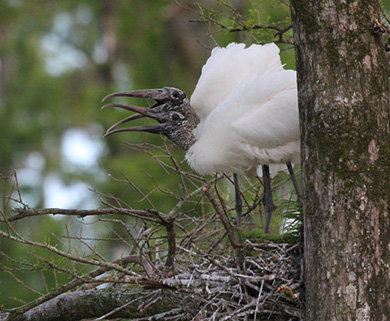December 17, 2019

A pair of wood storks. (SCDNR Photo/Christy Hand)
In 2019, South Carolina Department of Natural Resources (SCDNR) biologists and technicians counted the highest amount of wood stork nests ever recorded in the state's history.
SCDNR's Wading Bird Program counted 3,075 wood stork nests at 26 colonies in South Carolina, breaking the record high of 2,512 nests set during 2016. However, this increase likely reflects widespread nesting failure documented in south Florida.
According to South Florida Water Management District Lead Environmental Scientist Mark Cook, heavy rain in both January and April caused established nests to fail in south Florida.
In the 268 nests monitored in South Carolina this year, an average of two chicks per nest site survived to fledging age, and at least one chick survived to fledging age in 84% the nest sites.
The federal recovery goal for wood storks is an average of 1.5 fledglings per nest, and nesting success exceeded the goal this year at all but one of the six index colonies where nests are monitored on a weekly basis throughout the breeding season.
"At Dungannon Plantation Heritage Preserve, wood stork nesting was unsuccessful in the area of the colony where nest monitoring was conducted, but an additional 73 nests were counted later during the season in an unmonitored area of the colony and many of these nesting attempts were successful," said SCDNR Wildlife Biologist Christy Hand.
SCDNR has been surveying the wood stork nests since they began to nest in South Carolina during 1981. More information about SCDNR's Wading Bird Project.



